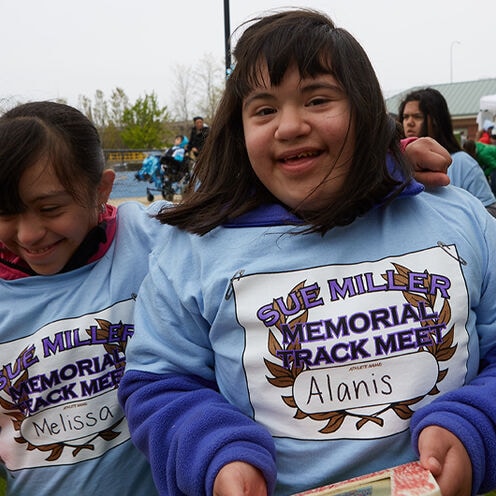
Special Education Allyship In Action
Special education teachers share how they promote advocacy, agency, and positive disability identity building in their classrooms.
All who work in schools, from teachers and principals to support staff members and administrators, play an important role in supporting students with dis/abilities. But special education teachers in particular have a unique responsibility and opportunity to amplify the voices of their students and to partner with them to ensure special education is designed as a tool for their empowerment and advancement.
To learn more about how this allyship plays out in classrooms across the nation, we spoke to four corps members who serve as special education teachers: Kourtney Kawano (Hawai'i ‘18), Lillian Stevens (New York ‘18), Hailey Shoemaker (Greater Tulsa ‘17) and Dana Queener (Eastern North Carolina ‘17).
These educators shared their vision for their classrooms and discussed the ways they set rigorous expectations and design their curricula to help their students in special education grow into adults who confidently advocate for their rights, needs, and future ambitions.
On Goal Setting
What does it mean for students to be strategic, goal-directed learners? Why is this so important for students with disabilities?
Lillian: Goals are super important because students need to find purpose in all their actions. Sometimes when you go through a school day and you have assignments and seven different classes going on, it's really easy to get lost, especially for a special education student who may feel they're falling behind in their courses or might feel overwhelmed.
I think it's really important to connect every single action back to their main goal. I try to do this by highlighting student strengths. As I get to know my students, we work together to identify their strengths. And so anytime I create a project or assignment, I try to point out where I know their strength can be highlighted. For example, I’ll say, "This would be a great place for you to use your drawing and sketches," to give purpose to each assignment and get them engaged in each one.
For all students, but especially for a student with disabilities, they need to realize why we're doing everything we're doing. If they have a goal that is written in their plan or written in the front of their notebook that they can constantly refer back to it, it’s really helpful, especially as we enter these busy times of year.
How can teachers empower their students to think about their future aspirations and develop goals in their education to reach these aspirations?
Dana: I think the first thing that teachers really need to understand is the importance of modeling what goals look like and modeling what career opportunities look like. Students need to be aware that there are millions of opportunities after high school, whether that's college, an internship, trade school, or pursuing a different option.
Do you have any examples of projects or lesson plan that allowed you to help students play an active role in setting goals that matter to them?
Kourtney: I’ve met with two of my juniors on my caseload to talk about their future aspirations and empower them by having them take a career-interest assessment that matches their interests to potential careers. Although this is an assessment that both students took before, it became more real during their junior year as they began to prepare themselves for life after high school. For both students, the ability to make decisions for themselves is a powerful tool that empowered them to want to talk more about their goals, as well as helped my students realize what they need to do in high school to be ready for their dream careers.
Students’ Needs & Rights
How do educators teach students to understand their rights as students and citizens broadly, and as students and citizens with disabilities?
Lillian: I think that advocacy is the thing that I push for most as a special education teacher and that I really want my students to take away. When I think about my students, they're in the 11th grade, so in a little over a year, they're going to be out in the real world. Their Individualized Education Plan (IEP) no longer exists. They no longer have someone guiding them, helping them, and advocating with them, so I push hard for advocacy.
Some of the ways that I do this is to just include students in our conversation. I think sometimes we get worried or unsure about having a conversation about IEPs and special education, but it’s important.
All of our students are very included in their IEP meetings. We go through their IEPs with them, we help them understand what it means, why they have it, how it's a tool for them and a resource. Then we let their perspective be heard in these meetings. We ask them, "Do you still think you need this service? Do you think you could do without it? What else do you think you might need?"
We also talk to them starting junior year about how once they go to college, they're going to have to be asking for their accommodations. We teach them how to have those conversations so they are prepared to advocate for their needs and accommodations.
How can teachers empower and teach students to advocate for themselves and their needs inside and outside of the classroom?
Hailey: A priority of mine is to teach my third and fourth grade students different “feeling” words. Some of my kids struggle with vocabulary, and by giving them words to describe their feelings, we can literally give students voice and allow them to express themselves. This can help students self-regulate, describe what’s happening in their bodies, ask for help, and figure out what they need to move to a more positive feeling. It’s also important for students to know that if they’re having a hard time in their general education room, or any other space, they have the right to come to my classroom if necessary.
What does it mean for students with disabilities to become advocates for themselves and others in their communities? Why is it so important?
Hailey: I have a culture in my room where it's okay to appropriately and respectfully ask questions about why we're doing something. I think that’s important because sometimes the expectation is that students will listen and not question a teacher or an authority figure. But knowing how to appropriately question something is the basis of advocacy. I think it’s really important that my students are able to see how that might be done and what it looks like.
I also try to give students a space where their needs are met so they're able to see, "This is what my best self can be." This can help them advocate in situations where their needs--or the needs of their peers--aren't being met, so they can name what's happening, what’s needed, and eventually take that awareness into other spaces as they grow older.
Disability as a Source of Strength and Pride
Why is it so important for students with disabilities to view disability as part of their social identity and as a source of pride?
Kourtney: I think it’s important for students to embrace who they are and understand all of the facets that make them similar to and different from others. Having a disability should be seen as just another facet of their identity. Even if they do not view disability as the most salient part of their social identity, they should realize that it is an important part of who they are - and one they can have pride in. In order to embrace their whole identity, students need to be proud of all facets, including disability.
How can teachers learn alongside students about disability as a social identity? Why is this so important?
Dana: It is so important for peer educators to be advocates for their students with disabilities by learning alongside them about disability. But for some teachers, concepts like “I have a disability,” “I’m on a IEP,” or “I have a 504 plan” are like a foreign language.That strikes a chord with me because it's so important for teachers to be well-rounded as educators.
All teachers need to learn and be willing to learn how to include students with disabilities, whether that be someone who has Cerebral Palsy, Down's syndrome, or those who suffer from extreme trauma. Students with disabilities need to feel welcome and valued in our schools. We must continue to grow as educators.
Growing As Educators and Allies
Alongside their students, Kourtney, Lillian, Hailey, and Dana continue to learn what it means to be an ally to special education students, and how to best support their students’ growth as advocates for themselves and for other members of the disability community.
“My kids help me confront my own biases every day. It’s not realistic to think we don’t have those biases,” Hailey says. “We all have conceptions in our head about how disability looks like. But having a relationship-based classroom helps me to challenge that, and to see my students as they truly are.”
Answers have been edited and condensed for clarity.
Sign up to receive articles like this in your inbox!
Thanks for signing up!
Content is loading...







